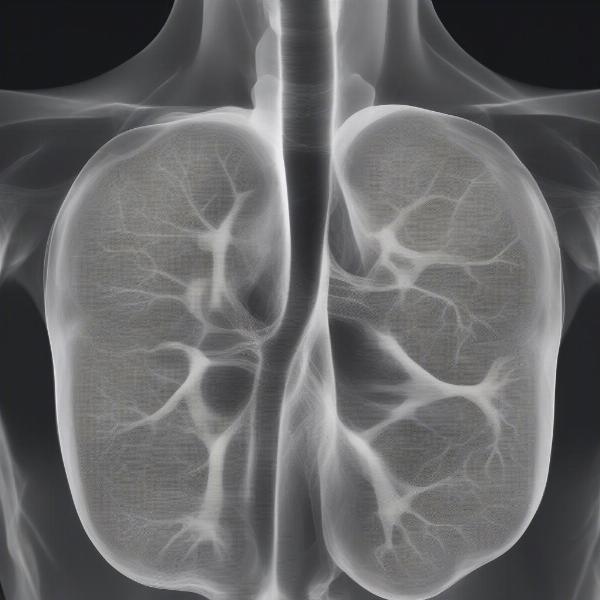The term “alveolar pattern” in dogs might sound complex, but understanding it is crucial for recognizing potential respiratory issues in your canine companion. This pattern, visible on a dog’s radiograph (x-ray), indicates a specific type of lung abnormality and can help veterinarians diagnose conditions like pneumonia. This article will delve into the alveolar pattern, its causes, associated symptoms, and the diagnostic and treatment options available.
 X-ray showing alveolar pattern in a dog
X-ray showing alveolar pattern in a dog
What Does an Alveolar Pattern Indicate?
An alveolar pattern on a radiograph signifies that the air sacs (alveoli) in the dog’s lungs are filled with fluid or cellular debris. This filling creates a hazy, opaque appearance on the x-ray, obscuring the normally clear lung fields. This consolidation can be localized to a specific lobe or affect the entire lung. Several conditions can cause this, including pneumonia, bleeding into the lungs, and certain types of cancer. Recognizing this pattern is the first step toward a proper diagnosis and effective treatment.
Common Causes of Alveolar Pattern in Dogs
Several factors can lead to the development of an alveolar pattern in dogs. Bacterial and viral infections are frequent culprits, leading to pneumonia. Aspiration pneumonia, which occurs when foreign material enters the lungs, can also cause this pattern. Other less common causes include pulmonary edema (fluid buildup in the lungs due to heart failure), pulmonary hemorrhage (bleeding into the lungs), and certain lung tumors.
Recognizing the Symptoms
Dogs with an alveolar pattern on their x-ray often exhibit respiratory distress. Common signs include coughing, rapid breathing, labored breathing, and exercise intolerance. Other symptoms may include fever, lethargy, loss of appetite, and nasal discharge. If you notice any of these signs in your dog, it’s essential to seek immediate veterinary attention.
Diagnosis and Treatment
Diagnosing the underlying cause of an alveolar pattern requires a combination of physical examination, radiographic findings, and sometimes additional tests like blood work, bronchoscopy, or lung biopsies. Treatment depends on the specific cause. Bacterial pneumonia typically requires antibiotics, while viral pneumonia often involves supportive care to help the dog’s immune system fight the infection. alveolar pattern in dogs Other conditions, like pulmonary edema or hemorrhage, require specific treatments targeted at the underlying issue. Early diagnosis and prompt treatment are crucial for a positive outcome.
What if My Dog Shows These Symptoms?
If your dog exhibits any signs of respiratory distress, such as coughing, rapid or labored breathing, or lethargy, it’s essential to contact your veterinarian immediately. They can perform a thorough examination and determine the appropriate diagnostic tests, including radiographs, to assess your dog’s condition and recommend the best course of action. aspiration pneumonia dog radiograph Don’t delay seeking professional help, as early intervention can significantly improve your dog’s chances of recovery.
Conclusion
Understanding the alveolar pattern in dogs is essential for recognizing potential respiratory problems. This radiographic finding can help veterinarians diagnose various conditions, including pneumonia, and guide treatment decisions. If your dog shows any signs of respiratory distress, don’t hesitate to seek veterinary care. Early diagnosis and treatment are crucial for ensuring a positive outcome and restoring your furry friend’s health. bleeding dog ears
FAQ
- What is an alveolar pattern in dogs? An alveolar pattern is a finding on a chest x-ray indicating that the alveoli (air sacs) in the lungs are filled with fluid or debris.
- What causes an alveolar pattern? Several conditions can cause it, including pneumonia, bleeding into the lungs, and certain types of cancer.
- What are the symptoms of an alveolar pattern? Symptoms include coughing, rapid breathing, labored breathing, lethargy, and loss of appetite.
- How is an alveolar pattern diagnosed? It’s diagnosed through a combination of physical examination, radiographs, and sometimes additional tests like blood work or bronchoscopy.
- How is an alveolar pattern treated? Treatment depends on the underlying cause and can range from antibiotics for bacterial pneumonia to supportive care for viral infections.
- Is an alveolar pattern serious? Yes, it can indicate a serious underlying respiratory issue, so prompt veterinary attention is crucial.
- Can an alveolar pattern be prevented? Some causes, like aspiration pneumonia, can be prevented by careful feeding practices.
About ILM Dog: ILM Dog is your trusted global resource for all things dog-related. We offer expert advice on dog breeds, health, training, nutrition, grooming, and much more. From choosing the right breed to understanding complex medical conditions, our team provides reliable, practical information to help you care for your canine companion. Contact us today to learn more about our services! Email: [email protected], Phone: +44 20-3965-8624.